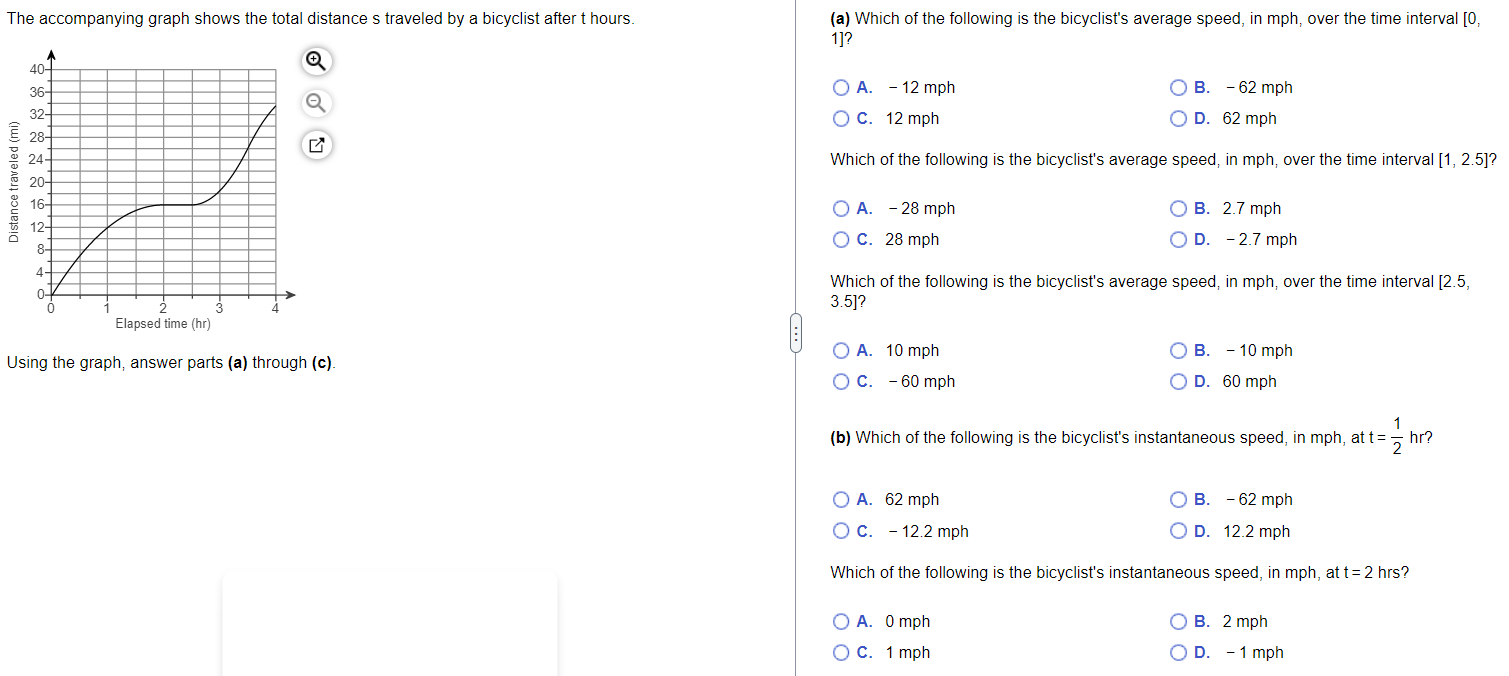Home /
Expert Answers /
Calculus /
the-accompanying-graph-shows-the-total-distance-s-traveled-by-a-bicyclist-after-mathrm-t-h-pa729
(Solved): The accompanying graph shows the total distance s traveled by a bicyclist after \( \mathrm{t} \) h ...
The accompanying graph shows the total distance s traveled by a bicyclist after \( \mathrm{t} \) hours. (a) Which of the following is the bicyclist's average speed, in mph, over the time interval [0, 1]? A. \( -12 \mathrm{mph} \) B. \( -62 \mathrm{mph} \) C. \( 12 \mathrm{mph} \) D. \( 62 \mathrm{mph} \) Which of the following is the bicyclist's average speed, in mph, over the time interval \( [1,2.5] ? \) A. \( -28 \mathrm{mph} \) B. \( 2.7 \mathrm{mph} \) C. \( 28 \mathrm{mph} \) D. \( -2.7 \mathrm{mph} \) Which of the following is the bicyclist's average speed, in \( \mathrm{mph} \), over the time interval \( [2.5 \), 3.5]? Using the graph, answer parts (a) through (c). A. \( 10 \mathrm{mph} \) B. \( -10 \mathrm{mph} \) C. \( -60 \mathrm{mph} \) D. \( 60 \mathrm{mph} \) (b) Which of the following is the bicyclist's instantaneous speed, in mph, at \( \mathrm{t}=\frac{1}{2} \mathrm{hr} \) ? A. \( 62 \mathrm{mph} \) B. \( -62 \mathrm{mph} \) C. \( -12.2 \mathrm{mph} \) D. \( 12.2 \mathrm{mph} \) Which of the following is the bicyclist's instantaneous speed, in mph, at \( \mathrm{t}=2 \mathrm{hrs} \) ? A. \( 0 \mathrm{mph} \) B. \( 2 \mathrm{mph} \) C. \( 1 \mathrm{mph} \) D. \( -1 \mathrm{mph} \)
Which of the following is the bicyclist's instantaneous speed, in \( \mathrm{mph} \), at \( \mathrm{t}=3 \mathrm{hrs} \) ? A. \( 10 \mathrm{mph} \) B. \( -35 \mathrm{mph} \) C. \( -15 \mathrm{mph} \) D. \( 35 \mathrm{mph} \) (c) Which of the following choices gives the maximum speed, in mph, and the time at which i oCCurs? A. The maximum speed of the bicyclist is \( 20 \mathrm{mph} \) and it occurs when \( \mathrm{t}=3.5 \mathrm{hrs} \). B. The maximum speed of the bicyclist is \( 45 \mathrm{mph} \) and it occurs when \( \mathrm{t}=1 \mathrm{hr} \). C. The maximum speed of the bicyclist is \( 20 \mathrm{mph} \) and it occurs when \( \mathrm{t}=1 \mathrm{hr} \). D. The maximum speed of the bicyclist is \( 45 \mathrm{mph} \) and it occurs when \( \mathrm{t}=3.5 \mathrm{hrs} \).

